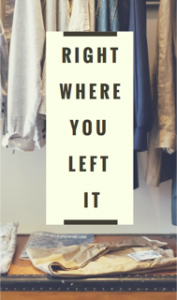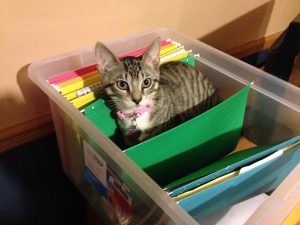 If being organized is not how you were raised but you’ve started to become more orderly, you may already know: it takes time getting used to “being organized.”
If being organized is not how you were raised but you’ve started to become more orderly, you may already know: it takes time getting used to “being organized.”
I learned this with a new client: Kim (not her real name) has struggled all her life to maintain a neat space. Her efforts go in waves and she has managed to live a really rich and creative life — but it hasn’t been easy. She’s lost a few things along the way. Paid her share of late fees for bills and penalties for misplaced parking tickets. And wasted time rewashing clothes after the dirty commingled with the clean.
When she was ready to stop this chaos…she called in a professional organizer.
She had 3 areas to organize:
• her wardrobe and bedroom
• her living room – including a desk area
• her hallway which had become an over-crowded storage space
We started in her bedroom because the mess was affecting her sleep. After 3 working sessions we had sorted through all of her clothes, cleared every surface (including the floor) of anything that didn’t belong, rearranged her dresser drawers and closet with zones for each type of clothing she needed in her life.
Moving on to the living room, Kim sheepishly told me a “funny” story about her missing slippers. The one constant in Kim’s life had been lots of weekends away to cabins with friends. In preparing to pack for one such weekend, she described how she had scoured her apartment looking for her slippers.
She checked ALL of her usual spots: under the coffee table, in the bathroom, kicked under the hallway table, in a pile behind the couch, tucked under her bed, tossed into a corner by her cat…she couldn’t find them anywhere.
She left for her weekend sans slippers in a bummed mood.
As soon as she got on the road to the cabin, it hit her. She couldn’t help but laugh out loud. Her slippers were right where we had left them — in their new home. They were in the bottom “bay” of the hanging shoe organizer we had installed in her closet.
It was a funny lesson to us both, that getting organized takes some getting used to! The motto of Kim’s story is: It’s easy to find what you need when you need it…when it is right where you left it.
 One of my favorite pieces on growth and development is a YouTube video I came across about a year ago. The interview was given by Rabbi Dr. Abraham Twerski on “how a lobster grows.” You may be asking, what’s the punchline? It almost sounds like a joke: “So there’s this rabbi and a lobster”… however, this short lecture is one that I have sent to colleagues and friends. I have shared it with family…I have even shared it repeatedly with my daughters who, as young women entering their teenage years, are starting to experience many types of growth. Unfortunately, growth often causes discomfort.
One of my favorite pieces on growth and development is a YouTube video I came across about a year ago. The interview was given by Rabbi Dr. Abraham Twerski on “how a lobster grows.” You may be asking, what’s the punchline? It almost sounds like a joke: “So there’s this rabbi and a lobster”… however, this short lecture is one that I have sent to colleagues and friends. I have shared it with family…I have even shared it repeatedly with my daughters who, as young women entering their teenage years, are starting to experience many types of growth. Unfortunately, growth often causes discomfort.
Dr. Twerski talks about the lobster being a soft, squishy animal that lives inside a hard shell. It is protected, but stunted. The hard shell – its current state… its “normal” – actually prohibits its growth and development. As the animal grows inside the shell, it becomes squeezed, uncomfortable and stunted and finds itself under a tremendous amount of stress.
Personally and professionally, when we begin to feel stress, it is largely due to an uncomfortable situation in which we find ourselves. What causes that discomfort or stress? Many times individuals or organizations believe stress is a result of external forces exerting pressure, when really the discomfort is a result of the individual’s, or organization’s growth that is being stunted. So how does an individual or organization alleviate discomfort? Does it stop growing? Become static? Being static leads to certain death. Lack of growth means that the rest of the world is changing while the individual or organization is not. Does it mask the stress? Masking stress only compounds it and makes it worse – procrastination is the enemy of growth and productivity.
Therefore, the lobster is forced to break out of its shell and expose its vulnerability to the world… and ultimately grow. Once the lobster is exposed and opens itself up to the newness around it, it is able to develop, become stronger and more resilient and grow a new, tougher outer shell. Similarly, individuals and organizations alike experience some stress during a period of growth. It forces an analysis of current situations and change.
The lobster analogy for growth and development is universal. It is applicable to individuals and organizations alike. Whether it is big or small, change can be difficult. However, the inevitable reward for embracing change is incomparable. As the NAPO blog investigates the topics within this theme of “growth” it is a great opportunity to take a step back to identify areas of potential growth. Opportunities to develop and areas for improvement help the individual, the organization or even the nation, illuminate pathways to success.
Courtesy of Kahra Buss, Membership Communication Manager, NAPO
 You thought you had trouble keeping your home organized; now you have to shrink your available space down to a mere 100th of that? With the airlines’ restrictions and charges on baggage, making efficient use of a 28”x 21”x 12” space (or smaller) will really exercise your organizing muscles! There are things you can do to make packing – whether for family vacation or summer camp – work better for you than it has in the past. Here’s how you can make the most of the little space you have (with partial thanks to AAA).
You thought you had trouble keeping your home organized; now you have to shrink your available space down to a mere 100th of that? With the airlines’ restrictions and charges on baggage, making efficient use of a 28”x 21”x 12” space (or smaller) will really exercise your organizing muscles! There are things you can do to make packing – whether for family vacation or summer camp – work better for you than it has in the past. Here’s how you can make the most of the little space you have (with partial thanks to AAA).
And once you’re up, up and away…
Click here to learn more about the author, Ellia Ryan.
 As a Productivity and Organizing Professional, I am preoccupied with effective ways to calm the chaos in people’s lives. When I saw this short 3 minute video, I thought it was a great demonstration of how disorganization and chaos unfold without notice while everything falls into disarray and nothing gets done. If you can relate, then here are 8 easy suggestions to help calm the chaos in your life.
As a Productivity and Organizing Professional, I am preoccupied with effective ways to calm the chaos in people’s lives. When I saw this short 3 minute video, I thought it was a great demonstration of how disorganization and chaos unfold without notice while everything falls into disarray and nothing gets done. If you can relate, then here are 8 easy suggestions to help calm the chaos in your life.
In the video, the chaos began when the actor put her keys down on the table to pick up the mail. In that moment, she lost her connection to her keys and shifted her attention to the mail. She no longer had a cognitive or tactile association with the keys. Her connection transferred to the mail instead. That loss of connection was played out over and over in the video as the chaos unfolded. She lost her awareness of her checkbook, the remote, her glasses and, ultimately, her ability to complete a task with ease.
If you must pick up the mail before putting your keys in their designated spot (create one if you don’t already have one), hold onto the keys. That is, stay connected to the keys while you are sorting the mail. Then, when your attention turns away from the mail, your keys will be in your hand as a tactile reminder that the task of putting your keys away is not complete.
If the actor had held onto her keys while she sorted the mail, or her checkbook while she walked to her desk and then to the kitchen with her warm Coke, both her keys and checkbook would have signaled to her that the task wasn’t done, and ultimately reduced the number of incomplete tasks left in her wake.
The video shows how random the actor moved from one task to another. What caught her attention became the next priority without thought or question. If this feels familiar, try counting to 8 slowly before you move from one task to another. This allows time to slow down and contemplate which task is more important and should be done first.
If the actor took time to stop and count to 8 before shifting from one task to another, she could have made conscious choices to either stop what she was doing and move to another task or not. Having time to choose lends itself to better outcomes and less chaos.
Taking on and practicing one or more of these suggestions, over time, will strengthen your ability to calm the chaos and be more effective, efficient and productive.
In oftentimes challenging situations loaded with minefields and judgments, have fun trying different ways to “stay connected” to a task. So I can’t forget things while I’m working, I wear a “task pouch” around my waist with pockets like a carpenter’s tool belt. In it is everything I need at my fingertips: phone, markers, scissors, and a pad and a pen to capture tasks to do and things to remember. This is my way of keeping worry and brain chaos at bay.
Be compassionate with yourself when taking on new practices. Misses and backsliding are common during any learning process.
If you find you need support, new ideas, a coach or a cheerleader as you take on new practices, give one of us a call. We would love to assist you in calming the chaos in your life!
 Whether your office is in your home or away from home, now is the perfect time to start getting organized for 2018. The holidays have not officially started, even though you wouldn’t know it by the decorations in some stores already. In addition, tax time will be here before you know it.
Whether your office is in your home or away from home, now is the perfect time to start getting organized for 2018. The holidays have not officially started, even though you wouldn’t know it by the decorations in some stores already. In addition, tax time will be here before you know it.
Think how you would feel if you did not use your floor for a filing cabinet. C’mon now, I know you do!
Here are 5 tips to help you get your office in order:
Productivity and efficiency will greatly improve if your office space is organized. You won’t spend an inordinate amount of time looking for things, you won’t spend additional money on items you already have, and you’ll be able to use the freed-up time doing those things that are important to you.
P.S. Now, de-clutter and organize your floor. You have just created extra space in your file cabinets and drawers in which to put those items.
Yes, there really is such a thing as Relocation Stress Syndrome!
Relocation Stress Syndrome, or RSS, was approved as a formal diagnosis in the early 1990’s. (And here you were thinking that everyone else must be so much better at relocating and that it was just YOU who weren’t handling this very well – not true!)
You are not alone if a relocation is stressing you out or making you feel like, perhaps, you’ve lost your marbles.
Although anyone can be impacted, the elderly are at greater risk of feeling the effects of RSS. Many NAPO professionals are skilled with organizing and managing relocations and the sometimes unpleasant side-effects. Some even specialize in senior moves exclusively!
Continue here to read more from NAPO Senior Move Management expert, Susan Osborne, as she describes the symptoms and strategies for facing this not uncommon relocation affliction.